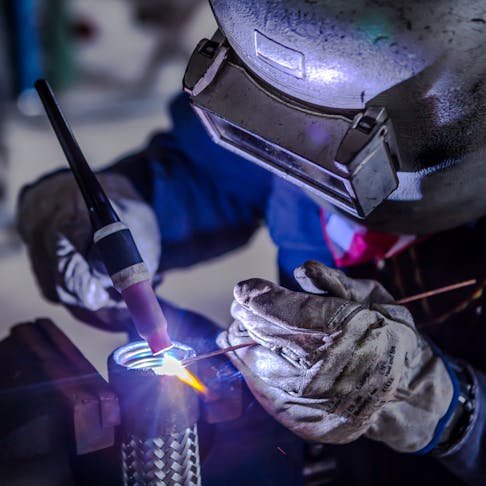Welding WPS for Beginners: Starting with Welding Procedure Requirements
Welding WPS for Beginners: Starting with Welding Procedure Requirements
Blog Article
The Ultimate Guide to Welding WPS Procedures: A Comprehensive Review for Welders
In the detailed world of welding, Welding Treatment Specs (WPS) act as the foundation of making certain top quality, uniformity, and safety in welding operations. Comprehending the nuances of developing, carrying out, and checking WPS treatments is essential for welders wanting to raise their craft and fulfill market criteria. As we look into the numerous parts of a WPS and check out the ins and outs of credentials and accreditation, we will reveal the important duty these treatments play in the realm of welding. Let's get started on a trip to unwind the complexities and importance of WPS treatments in welding methods.
Importance of WPS Procedures
Understanding the value of Welding Treatment Specs (WPS) procedures is vital for guaranteeing the quality and integrity of welded frameworks. WPS treatments work as a roadmap for welders, describing the needed steps, specifications, and materials needed to achieve a sound weld. By sticking to WPS standards, welders can ensure consistency in their work, leading to reliable and structurally sound welds.
One of the main factors why WPS treatments are necessary is their role in preserving weld top quality and honesty. Complying with the specified welding criteria and strategies laid out in the WPS helps stop issues such as porosity, splitting, or incomplete combination, which can endanger the stamina and toughness of the weld.

Parts of a WPS
A Welding Treatment Spec (WPS) typically consists of necessary components that information the particular demands for carrying out a weld, guaranteeing uniformity and high quality in the welding process. The vital elements of a WPS consist of crucial variables such as base metals, filler steels, preheat and interpass temperatures, welding processes, securing gases, welding positions, and post-weld warm treatment needs.
Base metals refer to the products being joined, while filler metals are used to fill up the gap in between the base steels during welding. The welding procedure describes the particular technique to be used, whether it's gas steel arc welding (GMAW), protected steel arc welding (SMAW), or one more technique. Welding placements specify the positionings in which welding can be performed.

Qualification and Accreditation
Having established the vital components of a Welding Treatment Spec (WPS), the emphasis now moves in the direction of the important aspects of certification and certification in welding techniques.

Certification, on the various other hand, is the official recognition of a welder's qualifications by an appropriate accreditation body or organization. Welding certifications are usually based upon the specific welding procedures, products, and settings a welder is certified to function with. Holding a valid welding qualification shows useful link that a welder fulfills sector standards and is qualified to execute welding jobs to the called for specifications.
Developing a WPS
To create a Welding Procedure Spec (WPS) that satisfies industry requirements, mindful consideration of welding processes, materials, and operational criteria is crucial (welding WPS). The primary step in producing a WPS is to recognize the welding process to be used, such as gas metal arc welding (GMAW) or protected metal arc welding (SMAW) Once the welding process is determined, the next vital aspect is picking the appropriate materials, considering variables like base metal type, density, and joint layout. Operational criteria such as welding present, voltage, travel rate, and securing gas composition must also be thoroughly specified in the WPS.

Carrying Out and Keeping Track Of WPS
Upon completing the extensive Welding Procedure Spec (WPS) that carefully details welding procedures, products, functional parameters, and top quality guarantee actions, the emphasis changes to effectively applying and monitoring the recognized procedures. Implementation includes making certain that all welders included in the task are familiar with the WPS and follow it meticulously throughout the welding procedure. Efficient implementation and surveillance of the WPS are critical for ensuring you could try here the stability, toughness, and safety of the bonded joints, ultimately contributing to the overall success of the welding project.
Verdict
In final thought, understanding and complying with Welding Procedure Requirements (WPS) is important for welders to ensure quality, uniformity, and safety in their job. By recognizing the parts of a WPS, getting appropriate credentials and qualifications, developing in-depth treatments, and executing and checking them efficiently, welders can boost their skills and effectiveness in welding practices. Following WPS treatments is vital for creating high-quality welds and conference industry requirements.
In the complex globe of check here welding, Welding Procedure Requirements (WPS) serve as the foundation of making sure quality, consistency, and safety and security in welding procedures. The welding process outlines the details method to be utilized, whether it's gas metal arc welding (GMAW), shielded steel arc welding (SMAW), or another method.To develop a Welding Procedure Specification (WPS) that meets sector standards, mindful consideration of welding procedures, products, and functional specifications is vital. The first action in creating a WPS is to recognize the welding process to be used, such as gas metal arc welding (GMAW) or protected metal arc welding (SMAW)Upon wrapping up the thorough Welding Procedure Specification (WPS) that carefully details welding procedures, materials, operational specifications, and quality guarantee steps, the focus moves to effectively implementing and checking the recognized procedures.
Report this page